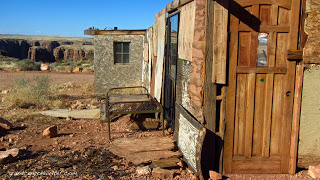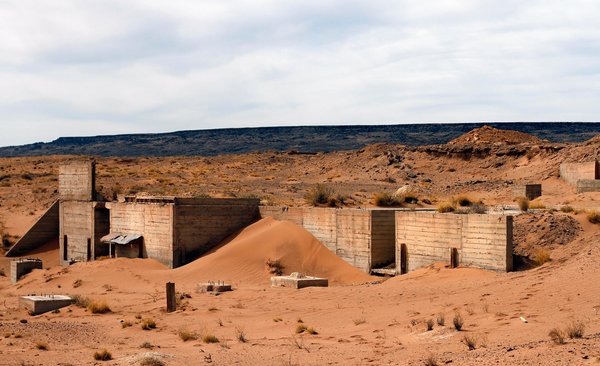 |
| Highly Toxic Uranium Mine in Cameron, AZ (New York Times 3/31/12) |
On Sunday, I had the opportunity to go for a walk with my friend Jeff who lives on the Navajo Reservation. His home, an Airstream parked across from the Cameron Trading Post, sits near the Little Colorado River in Cameron, Arizona. So that’s where we hiked: into the river drainage and then up a small canyon passing iron-colored cliffs stained here and there by chartreuse traces of uranium.
From the 1940’s to the 1980’s mining companies such as Union Carbide and many small, fly-by-night operations, blasted away at Navajo land, laying bare hundreds of uranium deposits and exposing thousands of workers to dangerous levels of radiation. When the cold war cooled off, those mines were abandoned by their owners. But though the mines might be closed, their radioactive legacy lives on.
 |
| Uranium deposit along Little Colorado River |
So far, the Environmental Protection Agency has evaluated 683 abandoned mines on the Navajo Nation. One of them, somewhere near where Jeff and I walked, emits a radiation dose of one million counts per minute—a level scientists say is a direct pathway to malignant tumors. Yet that site, identified in 2010 by a cattle rancher, has not been cleaned up. In fact, as of last March, it was not fenced off or even marked with a warning sign (New York Times 3/31/12, Uranium Mines Dot Navaho Land, Leslie MacMillan). Instead, tell-tale signs of visitors are present: empty beer cans, liquor bottles, and dung left by the Diné (Navajo’s) cattle.
The EPA says the reason clean up has been so slow—only 34 structures and 12 residential yards have been selected for remediation—has to do with money. There is not enough of it. And because most of the mining companies that made this toxic mess are long gone, it is we, the taxpayers that must foot the bill. Which, of course, we should do. To see this land is to see the indifference of America, it’s callous, self-serving, greed-infected side. The side that treats people like cogs in a machine, and treats machines as if it were gods. In the Navajo situation, the machine was the cold-war’s military industrial complex. We needed uranium for bombs, and we, the US Government, “were willing to do anything to get it,” according to LA Times Reporter Judy Pasternak in her important work Yellow Dirt.
Of course, it could be argued the Navajo’s should clean up this mess. It’s there land, their people, why not just let them do it? Again, money is the issue. The EPA estimates it could cost up to a billion dollars to clean these sites. With unemployment upwards of 40 percent, and median income only $20,000, where does a billion dollars come from? But there are other reasons the Navajo should not be left to clean up this cold war mess. There’s the lethargy that comes from poverty and neglect, the inertia and distrust that comes from centuries of discrimination and disregard, and there is the hopelessness that comes from knowing you are surrounded by an invisible enemy.
 |
| Navajo Trading Post on Hwy 64, Arizona |
The wind was blowing on Sunday as Jeff and I walk across the Navajo land, and we reassured ourselves it was blowing away from us. We were upwind. But of course the wind at our backs did come from somewhere.

The genocide continues with infected soil and air. People say, "It's not in my back yard, what do I care?". When the last full blood Navajo dies from cancerous growth, Uncle Sam can sign the deed and take back the reservation for it's own.
Thanks for this. I'm going to post a link to this on the Occupy Eugene Facebook site. They'll appreciate it. Also, your writing is simply scrumptious! I love reading each and every post. I've never been to the Grand Canyon, but I've been dreaming about it for a long time. Soon, insha'allah, soon..
Hi there, why is it that these charts be different from the readings available on http://radiationnetwork.com/index.htm ?? Radiation badge.
please educate me on why there appears to be a dissimilarity between the real time readings on Radiationnetwork and these charts you have displayed… thanks!
Tressler, I looked at the site you posted, and I see they do show that the area has nuclear waste. I do not think there is any active real time monitoring going on on the reservation, thus no data on the realtime site you posted. Thank you for asking and directing me toward that interesting site.
naseem